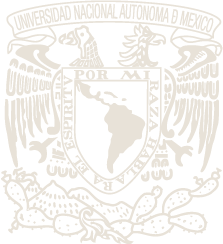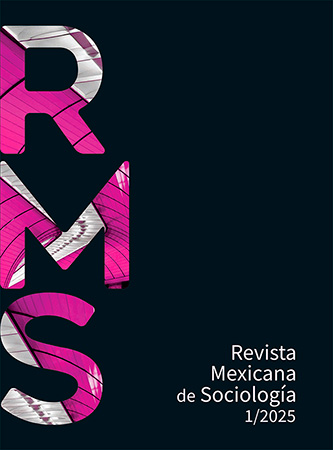Gangs from the Global South: Between youth groups and organized crime
Main Article Content
Abstract
Downloads
Article Details

This work is licensed under a Creative Commons Attribution-NonCommercial-NoDerivatives 4.0 International License.

Revista Mexicana de Sociología por Universidad Nacional Autónoma de México se distribuye bajo una Licencia Creative Commons Atribución-NoComercial-SinDerivar 4.0 Internacional. Basada en una obra en http://revistamexicanadesociologia.unam.mx/index.php/rms/.
References
Alarcón Gil, César (2014). “Ciudad Juárez: sociedad, criminalidad y violencia trasnacional”. En Ciudades en la encrucijada: violencia y poder criminal en Río de Janeiro, Medellín, Bogotá y Ciudad Juárez, coordinado por Ana María Jaramillo y Carlos Mario Perea, 249-329. Medellín: Corporación Región.
Aldridge, Judith, Juanjo Medina-Ariz y Robert Ralphs (2012). “Counting gangs: Conceptual and validity problems with the Eurogang definition”. En Youth Gangs in International Perspective, coordinado por Finn-Aage Esbensen y Cheryl L. Maxson, 35-51. Nueva York: Springer.
Alleyne, Emma, y Jane Wood (2010). “Gang involvement: Psychological and behavioral characteristics of gang members, peripheral youth, and nongang youth”. Aggressive Behavior 36 (6): 423-436.
Bangstad, Sindre (2005). “Hydra’s heads: pagad and responses to the pagad phenomenon in a Cape Muslim community”. Journal of Southern African Studies 31 (1): 187-208.
Bourgois, Philippe (1996). In Search of Respect: Selling Crack in El Barrio. Cambridge: Cambridge University Press.
Bush, Ray, y Habib Ayeb (coords.) (2012). Marginality and Exclusion in Egypt. Chicago: University of Chicago Press.
Castillo Berthier, Héctor (2004). “Pandillas, jóvenes y violencia”. Desacatos 14: 105-126.
Castillo Berthier, Héctor (2008). Juventud, cultura y política social: un proyecto de investigación aplicada en la ciudad de México, 1987-2007. México: Instituto Mexicano de la Juventud.
Castillo Berthier, Héctor, y Gareth Jones (2009). “Mean streets: Youth, violence, and daily life in Mexico City”. En Youth Violence in Latin America, 183-202. Nueva York: Palgrave Macmillan.
Cerbino, Mauro (2004). Pandillas juveniles: cultura y conflicto de la calle. Quito: Editorial El Conejo.
Cohen, Albert (1955). Delinquent Boys: The Culture of the Gang. Michigan: The University of Michigan.
Cordeiro, Denise (2009). Juventude nas sombras. Río de Janeiro: Faperj.
Cruz Salazar, Tania (2004). “Yo me aventé como tres años haciendo tags, ¡sí, la verdad, sí fui ilegal! Grafiteros: arte callejero en la ciudad de México”. Desacatos 14: 197-226.
Esbensen, Finn-Aage, y Cheryl Maxson (coords.) (2012). Youth Gangs in International Perspective. Nueva York: Springer.
Faull, Andrew (2007). Corruption and the South African Police Service: A Review and its Implications. Johannesburgo: Institute for Security Studies.
Feixa, Carles, José Sánchez-García, Eduard Ballesté, Ana Belén Cano, Maria-Jose Masanet, Margot Mecca y Maria Oliver (2019). La (Trans) banda: notas y cuestiones para la investigación con grupos juveniles de calle. Barcelona: Universitat Pompeu Fabra.
Glaser, Clive (2000). “Bo-Tsotsi”: The Youth Gangs of Soweto, 1935-1976. Ciudad del Cabo: David Phillip.
Goldman, Liran, Howard Giles y Michael Hogg (2014). “Going to extremes: Social identity and communication processes associated with gang membership”. Group Processes & Intergroup Relations 17 (6): 813-832.
Gomezjara, Francisco (1983). “Una aproximación sociológica a los movimientos juveniles y al pandillerismo en México”. Revista de Estudios sobre la Juventud 3 (8): 119-136.
Hagedorn, John, y Mike Davis (2008). A World of Gangs: Armed Young Men and Gangsta Culture, Vol. 14. Minnesota: University of Minnesota Press.
Hazen, Jennifer M., y Dennis Rodgers (coords.) (2014). Global Gangs: Street Violence across the World. Minnesota: University of Minnesota Press.
Jensen, Steffen (2014). “Intimate connections: Gangs and the political economy of urbanization in South Africa”. En Global Gangs: Street Violence across the World, coordinado por Jennifer M. Hazen y Dennis Rodgers, 29-48. Minnesota: University of Minnesota Press.
Jones, Gareth (2014). “ʽHecho en Méxicoʼ: Gangs, identities, and the politics of public security”. En Global Gangs: Street Violence across the World, coordinado por Jennifer M. Hazen y Dennis Rodgers, 255-280. Minnesota: University of Minnesota Press.
Jones, Nathan (2013). Understanding and Addressing Youth in “Gangs” in Mexico. San Diego: Wilson Center.
Kinnes, Irvin (2000). Monograph 48: From Urban Street Gangs to Criminal Empires: The Changing Face of Gangs in the Western Cape. Sudáfrica: Institute for Security Studies.
Klein, Malcom, y Lois Crawford (2004). “Groups, gangs, and cohesiveness”. En Gangs, coordinado por Jacqueline Schneider y Nick Tilley, 41-53. Londres: Routledge.
Levine, John, y Richard Moreland (1994). “Group socialization: Theory and research”. European Review of Social Psychology 5: 305-336.
Lewis, Oscar (1983). The Children of Sanchez. Nueva York: Penguin.
Lien, Inger-Lise (2005). “The role of crime acts in constituting the gang’s mentality”. En European Street Gangs and Troublesome Youth Groups: Findings from the Eurogang Research Program, coordinado por Scott H. Decker y Frank M. Weerman, 35-62. Oxford: Alta Mira Press.
Marcial, Rogelio (2020). “ʽSiempre firmes en terreno privadoʼ: violencias y masculinidades en jóvenes pertenecientes a pandillas de Guadalajara”. Densidades 28: 151-165.
Moore, Joan (1998). “Understanding youth gangs: Economic restructuring and the urban underclass”. En Cross-Cultural Perspectives on Youth and Violence, coordinado por Meredith W. Watts, 65-78. Stampford: jai Press.
Nateras Domínguez, Alfredo (2006). “Violencia simbólica y significación de los cuerpos: tatuajes en jóvenes”. Revista Temas Sociológicos 11: 71-101.
Peña Cortes, Diana Paola (2019). Conociendo los significados de la pandilla: estudio descriptivo desde la voz de tres mujeres jóvenes pertenecientes a pandilla del municipio de Puerto Tejada, Cauca. Cali: Universidad del Valle.
Perea Restrepo, Carlos Mario (2007). Con el diablo adentro: pandillas, tiempo paralelo y poder. Madrid: Siglo XXI Editores.
Petrus, Theodore, e Irvin Kinnes (2018). “New social bandits? A comparative analysis of gangsterism in the Western and Eastern Cape provinces of South Africa”. Criminology & Criminal Justice 19 (2): 179-196.
Pinnock, Don (1984). The Brotherhoods: Street Gangs and State Control in Cape Town. Ciudad del Cabo: David Phillip.
Pyrooz, David, Jillian Turanovic, Scott H. Decker y Jun Wu (2015). “Taking stock of the relationship between gang membership and offending”. Criminal Justice and Behavior 43 (3): 365-397.
Reséndiz Rivera, Nelly Erandy (2018). Violento, luego existo. Pandillas y maras en Guatemala. México: Universidad Nacional Autónoma de México.
Rodgers, Dennis (2009). “Slum wars of the 21st century: Gangs, mano dura and the new urban geography of conflict in Central America”. Development and Change 40 (5): 949-976.
Rodgers, Dennis, y Adam Baird (2016). “Entender a las pandillas de América Latina: una revisión de la literatura”. Estudios Socio-Jurídicos 18 (1): 13-53.
Rodgers, Dennis, y Steffen Jensen (2008). “Revolutionaries, barbarians or war machines? Gangs in Nicaragua and South Africa”. Socialist Register 45: 220-238.
Secretaría de Gobernación (Segob) (1968). “Decreto que reforma los artículos 15, 85, 193, 194, 195, 196, 197, 198, 199, 201, 306, 309 y 387; y adición del Artículo 164 Bis del Código Penal para el Distrito y Territorios Federales en materia de Fuero Común y para toda la República en materia Fuero Federal”. Diario Oficial de la Federación, 8 de marzo, pp. 2-3.
Secretaría de Seguridad Pública (SSP) (2010). Pandillas: análisis de su presencia en territorio nacional. México: Dirección General de Prevención del Delito y Participación Ciudadana.
Spindler, Andrea, y Martin Bouchard (2011). “Structure or behavior? Revisiting gang typologies”. International Criminal Justice Review 21 (3): 263-282.
Steinberg, Jonny (2004). Nongoloza’s Children: Western Cape Prison Gangs During and after Apartheid. Cape Town: Centre for the Study of Violence and Reconciliation.
Thrasher, Frederic Milton (1927). The Gang: A Study of 1 313 Gangs in Chicago. Chicago: University of Chicago Press.
Valenzuela Arce, José Manuel (2007). “La mara es mi familia”. En Las maras: identidades juveniles al límite, coordinado por José Manuel Valenzuela Arce, Alfredo Nateras Domínguez y Rossana Reguillo Cruz, 33-61. México: Universidad Autónoma Metropolitana-Iztapalapa.
Vargas Casillas, Leticia Adriana (2003). Pandilla, asociación delictuosa y delincuencia organizada en el nuevo Código Penal para el Distrito Federal. México: Universidad Nacional Autónoma de México-Instituto de Investigaciones Jurídicas.
Vigil, James Diego (1988). Barrio Gangs: Street Life and Identity in Southern California. Texas: University of Texas Press.
Vigil, James Diego (2014). “Cholo!: The migratory origins of Chicano gangs in Los Angeles”. En Global Gangs: Street Violence across the World, coordinado por Jennifer M. Hazen y Dennis Rodgers, 49-64. Minnesota: University of Minnesota Press.


